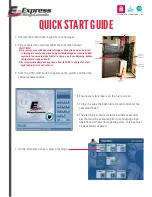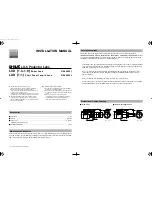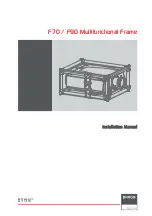FXTH870xD
Sensors
98
Freescale Semiconductor, Inc.
12.13
Telegram Verification
The LFR has control bits to allow flexibility in the telegram format and protocol to allow the LFR to adapt to a variety of systems.
The LFR can operate in a normal data receive mode where it receives complete telegrams, or in a carrier detect mode where it
only checks for a carrier. In the carrier detect mode, as soon as a carrier is detected, the LFCDF flag is set. If LFCDIE is also set,
an interrupt request is sent to wake the MCU
The format of the complete Manchester encoded datagram is comprised of a Manchester data preamble (series of Manchester
1’s or 0’s), a synchronization period, an optional ID, and zero to n data bytes.
The synchronization period can be used for synchronizing the beginning of the data packet. The SYNC pattern that follows the
preamble can be either a 6-, 7.5- or 9 bit-time non-Manchester pattern as shown in
Figure 73
.
Figure 73. SYNC Patterns
These patterns would normally not appear anywhere in the Manchester encoded portion of a message so there is no possibility
that the LFR could accidentally synchronize to a message that was already in progress when the LFR started listening for a
message. These patterns are also complex enough so that it is very unlikely that noise or interference could be mistaken for these
SYNC patterns. In the data mode and after the detection of a valid carrier, the LFR will decode the data stream waiting for the
SYNC word. Should this carrier not be an accepted TPMS type, no SYNC will be received and the LFR module will stay in data
receive mode forever. A timeout counter is thus started after a carrier detection and will stop the receiver if reaching the
programmed value selected by the TIMOUT[1:0] bits in the LFCTL4 register. This timeout counter is clocked by the internal LFRO
clock.
The LFR can be configured to have an optional 0, 8-bit or 16-bit ID after the SYNC pattern. If the ID value matches the received
ID, the message is accepted. The ID value can be used to identify a specific receiver, a message type, or some other identifier
as defined by application software.
Any number of data bytes can be included after the ID. The LFR begins to assemble data bytes from the incoming signal as soon
as the ID check is complete. If the first bit-time after the last bit of the ID does not conform to Manchester coding requirements,
the LFR considers the message complete and terminates the LFR operation without setting the data ready flag (LFDRF). If data
follows the ID, it is serially received and when 8 bits have been received the LFR copies this byte into the LFDATA register and
sets the LFDRF flag. If the LFDRIE interrupt enable is also set (and it should be), an interrupt request is sent to wake the MCU
so it can read the data and process it according to the instructions in the application program. Additional bytes are received until
a bit time that is not Manchester encoded is found. If a non-Manchester bit time is found, the LFERF bit will be set and indicates
a Manchester coding error. If this happens on the first bit of the next byte of the message the LFEOMF bit will also be set.
The preamble is a period of Manchester bits before the SYNC pattern as shown in
Figure 74
. The SYNC pattern will only be
matched for the bit times specified by the SYNC[1:0] control bits. Depending on the expected SYNC pattern the allowed
preambles is as described for the SYNC[1:0] bits in the LFCTL3 register.
T
T
T
T
2T
2T
1.5T
T
T
T
T
2T
2T
1.5T
3T
T
T
T
T
2T
2T
6-bit
(6T)
Pattern
7.5-bit
(7.5T)
Pattern
9-bit
(9T)
Pattern
SYNC[1:0] = 01
SYNC[1:0] = 10
SYNC[1:0] = 11
Summary of Contents for FXTH870 D Series
Page 86: ...FXTH870xD Sensors 84 Freescale Semiconductor Inc Figure 57 Data Flow For Measurements...
Page 171: ...FXTH870xD Sensors Freescale Semiconductor Inc 169 Figure 128 QFN Case Outline...
Page 172: ...FXTH870xD Sensors 170 Freescale Semiconductor Inc Figure 129 QFN Case Outline...
Page 173: ...FXTH870xD Sensors Freescale Semiconductor Inc 171...


















